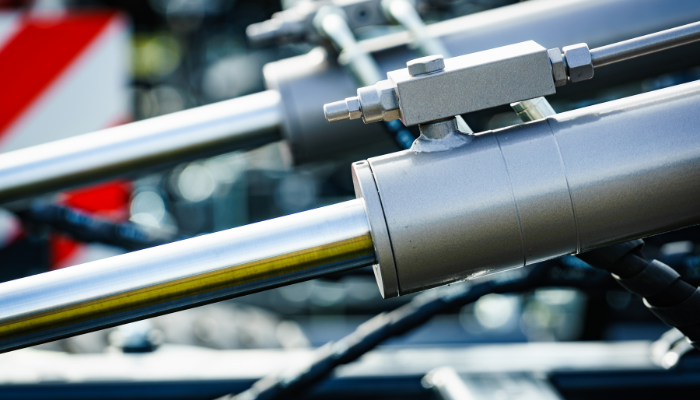Hydraulic applications face a variety of frustrating, but usually predictable challenges. Fluid contamination, system leaks, overheating, component fatigue, and design mistakes are problems as old as hydraulic engineering itself, and can be extremely damaging when they occur. The phrase ‘prevention is better than cure’ is one of the mantras that fluid power engineers live by, especially when they are responsible for system maintenance.

In this article, we’ll look at five of the most common challenges faced by hydraulic systems and how to overcome them, or at least minimise risk, at the design stage.
1. Fluid Contamination
Fluid contamination is a pervasive challenge that, if unaddressed, can significantly undermine the performance and longevity of a hydraulic application. Hydraulic fluid can easily become contaminated by water ingress, as well as particulate matter and air bubbles, leading to increased fatigue on system components and reduced fluid effectiveness.
Solution: The incorporation of modern filtration systems into the design of every hydraulic system, accompanied by regular fluid analysis and adherence to strict maintenance practices can all help mitigate the risk of fluid contamination and preserve the purity of your hydraulic fluid.
2. Leaks
Leakage is the bane of any hydraulic application, and is often the result of pressure differentials, thermal expansion, or defective components. Leakage can reduce system efficiency, increase energy consumption, trigger safety risks, and cause environmental hazards if toxic hydraulic fluids and lubricants escape into the ecosystem.
Solution: adopting a zero-tolerance policy towards leaks at the design stage is the first step towards problem mitigation. This includes specifying only the highest quality connections and fittings, and seals that are rated for the appropriate system pressures and are compatible with your hydraulic fluids. Your design should also consider thermal contraction and expansion to prevent undue stress on your components – one of the most common causes of leaks.
3. Overheating And Thermal Management
All fluid power systems generate heat. However, excessive heat within a hydraulic system can not only degrade the quality of the hydraulic fluid and accelerate ageing but also diminish the system’s performance. Common causes of thermal overload include overworking the system past its intended limits, undersized components (often installed during repairs or maintenance) and operating in high temperature environments.
Solution: unfortunately, there is no magic wand for effective thermal management, and a tailored approach is required that considers the application’s unique operating conditions, usage patterns, and output requirements. Ultimately, ensuring the correct fluid volume, adequate cooling pathways, and the appropriate oil cooler can go a long way in helping to manage temperatures in operation. Also, incorporating heat exchangers into the design and specifying a synthetic hydraulic fluid with higher thermal stability can be advantageous for applications designed to operate in high-temperature areas.
4. Component Wear And Fatigue
As mechanical systems, component wear, fatigue, and eventual failure is inevitable in hydraulic applications due to the high forces and pressures exerted on moving parts. Over time, worn components can degrade performance and eventually fail, necessitating maintenance or repair.
Solution: if wear and tear is a fact of life, can it be addressed at the design stage? In part, yes. Specifying components with the adequate strength, material hardness, and wear resistance to achieve your performance goals is the critical first step in minimising component fatigue and preventing unscheduled downtime. Additionally, to mitigate accelerated wear, it’s important to design systems that operate within the designated temperature and pressure parameters of your chosen components.
5.Noise And Vibration
Fluid power systems can be infamous for generating noise and vibrations, ranging from a nuisance to a sign of an impending system fault. Abnormal vibrations or noise levels are a telltale sign of an underlying issue, often due to cavitation, pressure spikes, or mechanical imbalances.
Solution: system design plays a crucial role in reducing noise and vibration. Specifying components that are finely machined and balanced, using pipes and hoses with the adequate flexibility and damping qualities, and employing proper mounting and isolation for all components can help to minimise vibrations while in use. Converting pressure spikes with accumulators or throttling techniques can also help minimise system noise.
Find Out More
Understanding the common challenges faced by hydraulic systems can help engineers implement solutions at the design stage that pay dividends in improved performance and efficiency. To find out more, please get in touch with one of our hydraulic design specialists today by clicking here.
Image source: Canva


